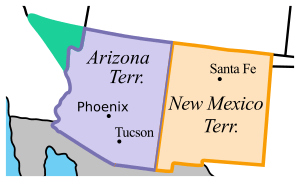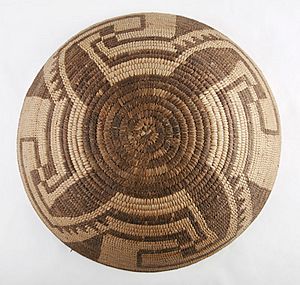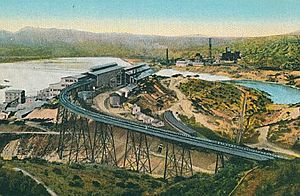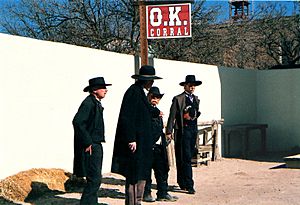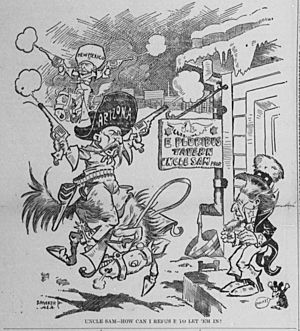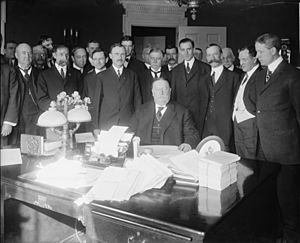History of Arizona facts for kids
The history of Arizona covers many periods, from ancient times to today. About 10,000 to 12,000 years ago, early people called Paleo-Indians lived here. Later, groups like the Ancestral Puebloans, Hohokam, Mogollon, and Sinagua cultures thrived. But these civilizations mysteriously disappeared in the 1400s and 1500s. Today, you can still find many ancient ruins in Arizona.
Arizona was once part of Sonora, Mexico, starting in 1822. Not many people lived there then. In 1848, after the Mexican–American War, the United States gained the land north of the Gila River. This became part of the New Mexico Territory. Later, in 1854, the U.S. bought the southern part of Arizona from Mexico through the Gadsden Purchase.
In 1863, Arizona became its own territory, separate from New Mexico. Travel became easier when railroads arrived in 1880. Arizona officially became a state in 1912. Back then, it was mostly rural, with an economy based on cattle, cotton, citrus, and copper. After 1945, Arizona grew a lot. Many people moved there for the warm weather and lower costs.
Contents
Arizona Under Mexican Rule (1840s)
In the 1840s, Arizona was a remote and poor part of northern Mexico. The main town was Tucson, with only a few hundred Mexican residents. There was also a small military fort with about 100 soldiers. A mission that had been there closed in 1828.
Most of Arizona south of the Gila River was part of the Mexican state of Sonora. A small eastern part belonged to Chihuahua. North of the Gila River, Arizona was technically part of Alta California and a bit of Santa Fe de Nuevo México in the east.
The soldiers, with help from Pima and Papago fighters, tried to protect the area. They faced attacks from the Apache people to the east of the San Pedro River and north of the Gila.
Mexican-American War Impact
During the Mexican–American War, the Mexican commander in Tucson avoided fighting. He left the town as American troops, led by Lieutenant Colonel Philip St. George Cooke and the Mormon Battalion, marched through. In 1848, the Treaty of Guadalupe Hidalgo ended the war. Mexico gave the U.S. the northern 70% of what is now Arizona. This land was north of the Sonora border along the Gila River.
After the war, the California Gold Rush began. In 1849, over 50,000 men traveled through Arizona on the Southern Emigrant Trail to reach the gold fields. The Pima Villages often sold fresh food to these travelers. They also helped those who were struggling on their journey.
Arizona Becomes American Territory

From 1853, all of what is now Arizona was part of the New Mexico Territory. The California Gold Rush in 1849 brought many miners through the region. This caused Arizona's population to grow.
In 1853, President Franklin Pierce sent James Gadsden to Mexico City. He negotiated with Santa Anna. The United States then bought the remaining southern part of Arizona and New Mexico. This deal was called the Gadsden Purchase.
Before 1846, Apache raids had driven away most Mexican ranchers. This led to large herds of wild cattle in southeastern Arizona. By 1850, these herds were gone. They had been killed by Apaches, American hunters, and for food for soldiers and gold rush travelers.
Civil War in Arizona
During the American Civil War, some citizens in southern New Mexico Territory wanted to join the Confederacy. This happened on March 16, 1861, around Mesilla and Tucson. They especially wanted mail service to be restored. These people hoped for a Confederate Territory of Arizona. However, in March 1862, Union troops from California took control. They returned the area to the New Mexico Territory.
The Battle of Picacho Pass took place on April 15, 1862. It was one of many Civil War battles in Arizona. Three groups fought: Apaches, Confederates, and Union forces. In 1863, the U.S. divided New Mexico. This created the Arizona Territory. Prescott was a small village that became the capital in 1877. Later, Tucson became the capital.
Controlling Native American Lands
In the late 1800s, the U.S. Army built forts to keep Native Americans on reservations. Fort Defiance was built in 1851 to control the Navajos. Small fights were common. In April 1860, a thousand Navajo warriors attacked the fort but were defeated. The fort was left empty during the Civil War. But it was reoccupied in 1864 by Colonel Kit Carson. His forces trapped the Navajos and made them take the "Long Walk" to a reservation. The Navajos promised to stop raiding and focused on raising sheep. Fort Defiance served the Navajo reservation until 1936. Today, it provides medical care.
Fort Apache was built on the Fort Apache Indian Reservation in 1870. Only one small battle happened there in September 1881. The fort closed permanently in 1924 when reservation Indians became U.S. citizens. Fort Huachuca, near Tucson, was founded in 1877. It was a base for operations against Apaches and raiders from Mexico. From 1913 to 1933, it was home to the "Buffalo Soldiers." These were black soldiers of the 10th Cavalry Regiment. During World War II, the fort grew to 25,000 soldiers, mostly in all-black units. Today, Fort Huachuca is still active. It houses the U.S. Army Intelligence Center.
Ranching in Arizona
After the Civil War, Texans brought large-scale ranching to southern Arizona. They used their proven methods for raising cattle. But some cattle thieves also arrived, bringing lawlessness. Inexperienced ranchers sometimes managed their herds poorly. This led to too many cattle and diseases. Local cattlemen formed groups to deal with these issues.
Arizona had a cattle boom from 1873 to 1891. The number of cattle grew from 40,000 to 1.5 million. However, a drought from 1891 to 1893 killed over half the cattle. It also caused severe overgrazing. Efforts to fix the rangeland between 1905 and 1934 had limited success. But ranching continued on a smaller scale.
Arizona's last major drought was during the Dust Bowl years of 1933–34. The government stepped in to help. The Agricultural Adjustment Administration spent $100 million to buy starving cattle. The Taylor Grazing Act put federal and state agencies in charge of livestock numbers on public lands. Most land in Arizona is owned by the federal government. It leased grazing land to ranchers at low cost.
Copper Mining Boom
In 1885, Lewis Williams opened a copper smelter in Bisbee. This started the copper boom. The nation needed copper wires for electricity. When railroads arrived in the 1880s, mining became even more profitable. Large companies bought mines and invested in new equipment. Mining operations grew in many boom towns. These included Bisbee, Douglas, Ajo, and Miami.
Wild West Stories
Arizona earned its "wild west" reputation. Tombstone was a famous mining town. It thrived from 1877 to 1929. Silver was found there in 1877. By 1881, the town had over 10,000 people.
Western storytellers and Hollywood filmmakers made Tombstone famous. This was thanks to Wyatt Earp and his brothers, who arrived in 1879. They bought shares in a mine, water rights, and gambling businesses. Wyatt and his brothers, Virgil and Morgan, also became federal and local marshals. They killed three outlaws in the Gunfight at the O.K. Corral. This was the most famous gunfight of the Old West. Afterward, Virgil Earp was injured in an ambush. Morgan Earp was killed while playing billiards.
Many movies have been made about Wyatt Earp's time in Tombstone. These include My Darling Clementine (1946) and Gunfight at the O.K. Corral (1957). These films helped make Earp known as one of the Old West's deadliest gunmen.
Arizona in the 20th Century
Growing Tourism
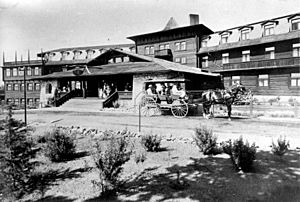
By 1869, Americans were reading about John Wesley Powell's explorations of the Colorado River. In 1901, the Santa Fe Railroad reached the Grand Canyon's South Rim. With the railroad and businessman Fred Harvey leading the way, large-scale tourism began. It has continued ever since. The Grand Canyon has become a famous symbol of the West and the entire nation.
Chinese Immigrants
Chinese people came to Arizona when the Southern Pacific Railroad was built in 1880. Tucson became a main railroad center. Soon, it had a Chinatown with laundries, restaurants, and stores. Chinese and Mexican merchants and farmers worked together. They formed friendships and trust. Chinese people leased land from Mexicans. They ran grocery stores. They also helped other Chinese people enter the U.S. from Mexico after the Mexican Revolution in 1910. Chinese merchants even helped supply General John Pershing's army. Successful Chinese people in Tucson built a strong community based on friendship and family.
Becoming a State
In 1912, Arizona almost became a state with New Mexico. This was a plan by the Republican party to keep control of the U.S. Senate. Most people in New Mexico accepted the plan, but most Arizonans did not.
Progressives in Arizona wanted new ideas in their state constitution. These included initiative, referendum, recall, direct election of senators, and women's right to vote. Most of these ideas were put into the constitution sent to Congress in 1912. President Taft signed the statehood bill on February 14, 1912. Arizona residents quickly put the ideas back into their constitution.
Hispanic people had little say in this process. Only one of the 53 delegates at the constitutional convention was Hispanic, and he refused to sign. In 1912, women in Arizona gained the right to vote. This was eight years before women across the whole country could vote.
Arizona's first Congressman was Carl Hayden (1877–1972). He was a liberal Democrat. Hayden was elected to Congress in 1912 and became a Senator in 1926. He was reelected many times. He became chairman of the powerful Appropriations Committee in 1955. He retired in 1968 after 56 years in Congress. His biggest achievement was working for 41 years to create the Central Arizona Project. This project would bring water for future growth.
The Great Depression in Arizona
The Great Depression (1929-1939) hit Arizona hard. At first, local and private groups offered charity. Federal money started arriving in 1930. Different agencies helped the unemployed, sick people, and immigrants. But the money ran out by 1931 or 1932. Conditions were bad until New Deal programs began in 1933.
Construction projects were very important. One major project was Hoover Dam (originally called Boulder Dam). It was built on the Colorado River border with Nevada. Construction happened between 1931 and 1936. The dam helped manage water use. Arizona received 19% of the river's water.
Arizona During World War II
Building military bases in Arizona was a national priority during World War II. The state had great flying weather, clear skies, lots of empty land, good railroads, and low taxes. It was also close to California's aviation industry. Arizona was attractive to both the military and private companies. Many stayed after the war.
Fort Huachuca became one of the largest Army forts for African-American soldiers. The 92nd and 93rd Infantry Divisions, made up of African-American troops, trained there.
During the war, Mexican-American community groups were very active. They supported American troops and the war effort. They provided moral support for young Mexican-American men fighting. Some projects involved both Mexican-American and Anglo communities. But many efforts in the Mexican-American community were separate. Mexican-American women formed groups like the Spanish-American Mothers and Wives Association. They raised money, wrote letters, and celebrated their culture.
Heavy government spending during World War II boosted Arizona's economy. It was still based on copper mining, citrus and cotton crops, and cattle ranching. Tourism was also growing. Military bases were built across the state. These included Davis-Monthan Field in Tucson, a main training center for bomber pilots. Two camps were also opened for Japanese and Japanese Americans. They were moved there from the West Coast.
Arizona After 1945
Arizona's population grew very fast after 1945. It jumped from about 700,000 in 1950 to over 5 million in 2000. Most of this growth was in the Phoenix area. Tucson was the second largest. This urban growth ended the state's citrus industry. Citrus groves were turned into housing developments. Growing cotton became less profitable due to water costs. So, cotton production steadily declined.
However, manufacturing jobs increased a lot. From 49,000 workers in 1960, it grew to 183,000 by 1985. Half of these workers were in high-tech companies. These included Motorola, Hughes Aircraft, Goodyear Aircraft, Honeywell, and IBM in the Phoenix area. By 1959, Hughes Aircraft in Tucson had five thousand workers building advanced missiles.
National Leaders from Arizona
Even though Arizona is a smaller state, it produced many national leaders. Two Republican Senators became presidential nominees: Barry Goldwater in 1964 and John McCain in 2008. Both won Arizona but lost the national election. Senator Ernest McFarland, a Democrat, was the Majority Leader of the U.S. Senate from 1951-1952. Congressman John Rhodes was the Republican Minority Leader in the House from 1973-1981.
Democrats Bruce Babbitt (Governor 1978-1987) and Morris Udall (Congressman 1961-1990) ran for their party's presidential nomination. In 1981, Sandra Day O'Connor became the first woman on the Supreme Court. She served until 2006.
Environmental Concerns

Arizona faced many debates about its fragile natural environment. Water shortage and how to distribute it were big issues.
Farming used 89% of the state's limited water supply. But it only made up 3% of the state's income. The Groundwater Management Act of 1980, supported by Governor Babbitt, raised water prices for farmers. Cities had to reach a "safe yield." This meant that groundwater use could not be more than what nature replaced. New housing developments had to prove they had enough water for the next hundred years. Desert plants that need less water soon replaced water-guzzling grass in Arizona lawns.
Cotton farming decreased a lot. This freed up land for new neighborhoods. It also saved large amounts of water. Cotton acreage dropped from 120,000 acres in 1997 to only 40,000 acres in 2005. About 80% of Arizona's cotton is sent to factories in China and Mexico.
Images for kids
-
A map showing the extent of the Ancestral Puebloan, Hohokam, and Mogollon cultures within the American Southwest and Northern Mexico, all 3 of which were based in what is now Arizona and/or New Mexico in around 1350 CE
-
Sinagua cliff dwelling (Montezuma Castle), Arizona, built in around 1100 CE
-
The Great House at the Casa Grande Ruins National Monument
-
Sinagua petroglyphs at the V Bar V Heritage Site
See also
 In Spanish: Historia de Arizona para niños
In Spanish: Historia de Arizona para niños



